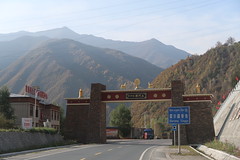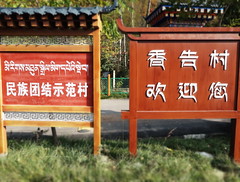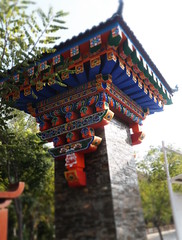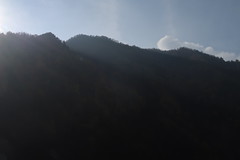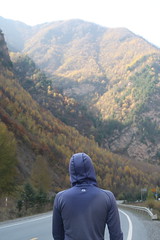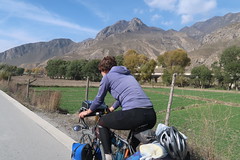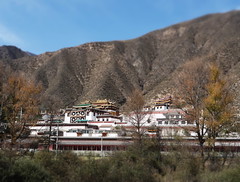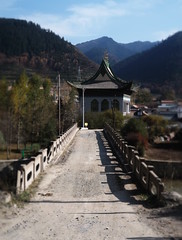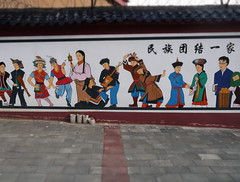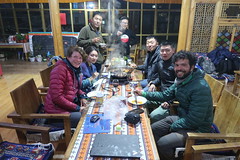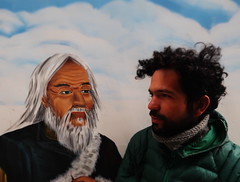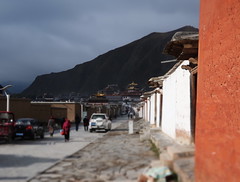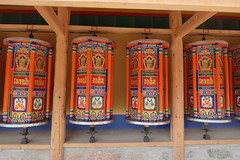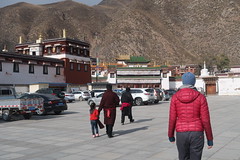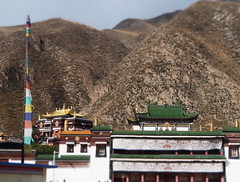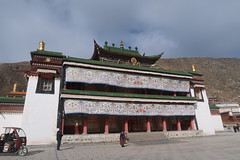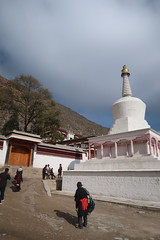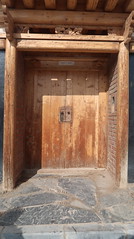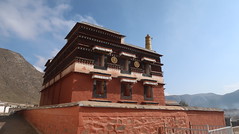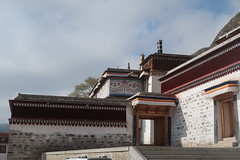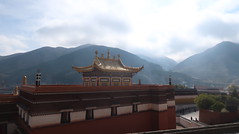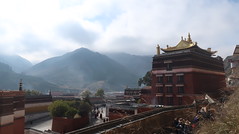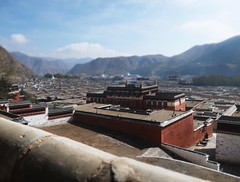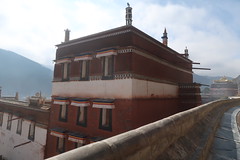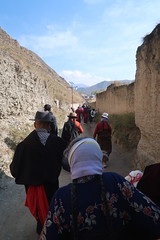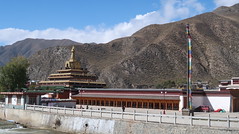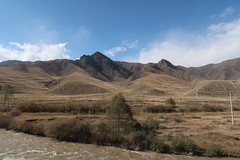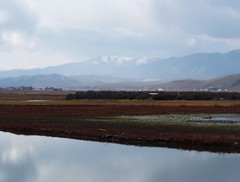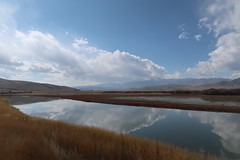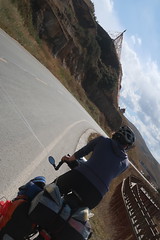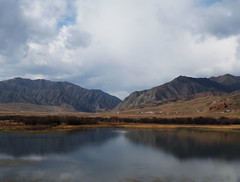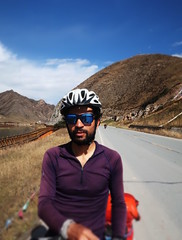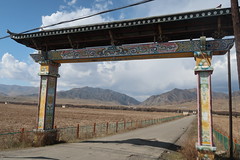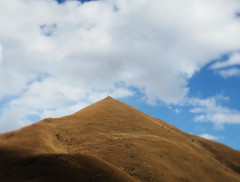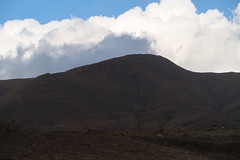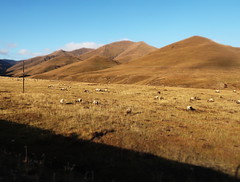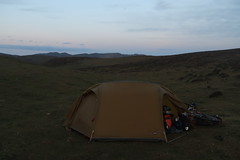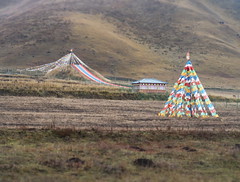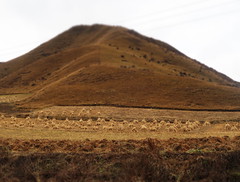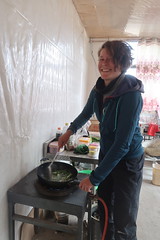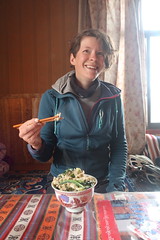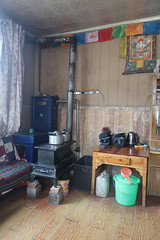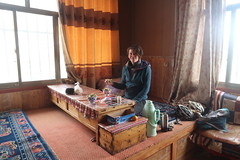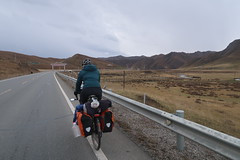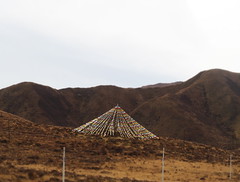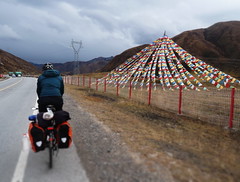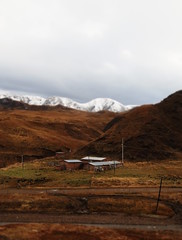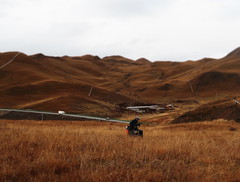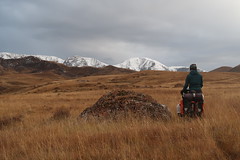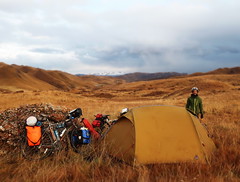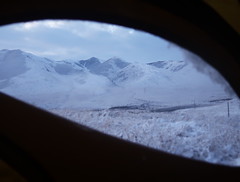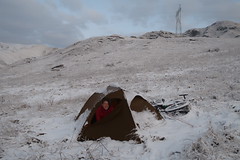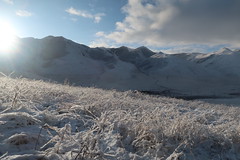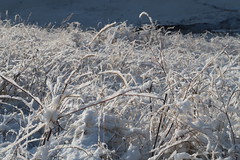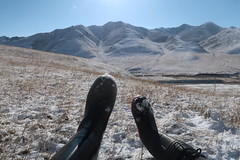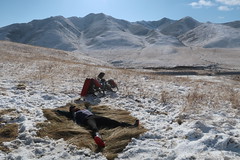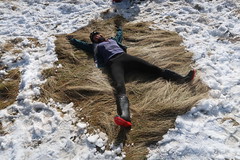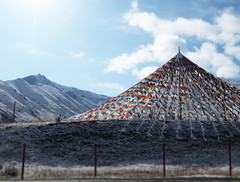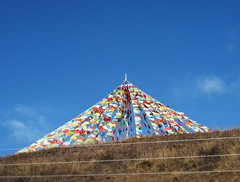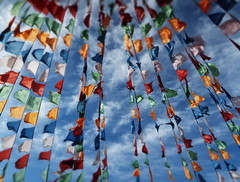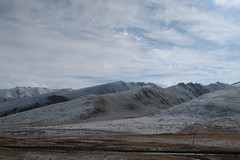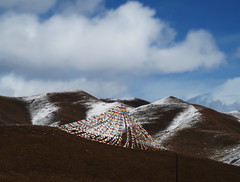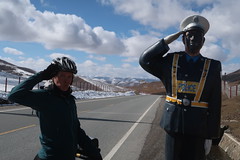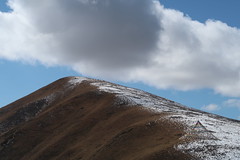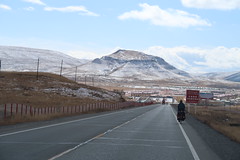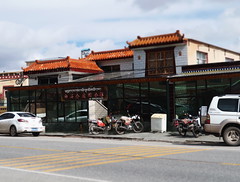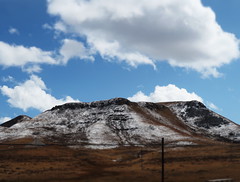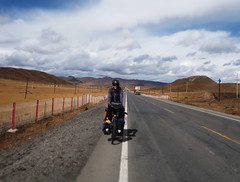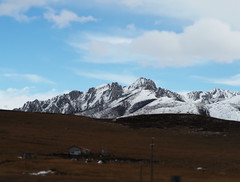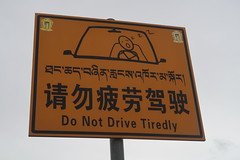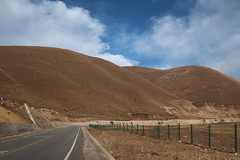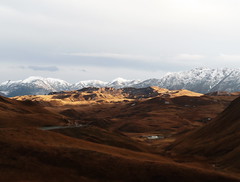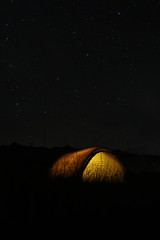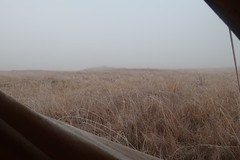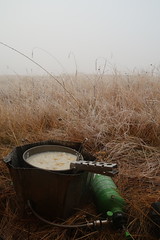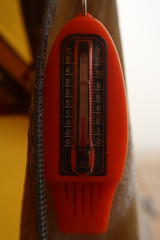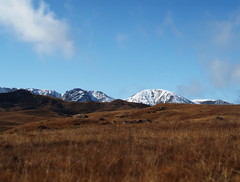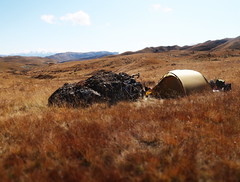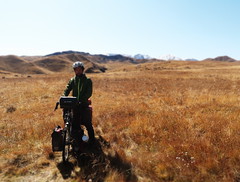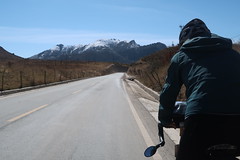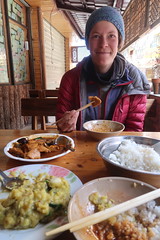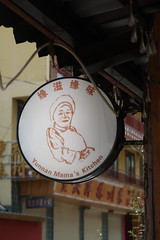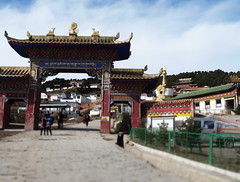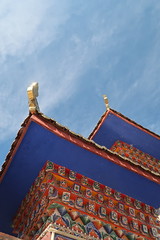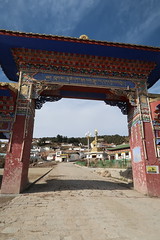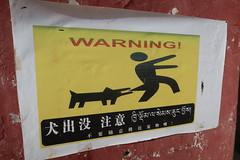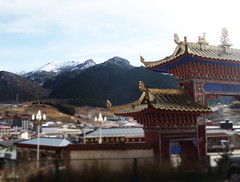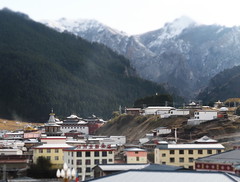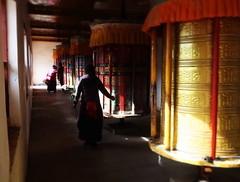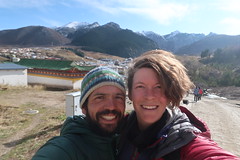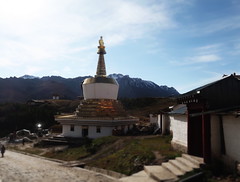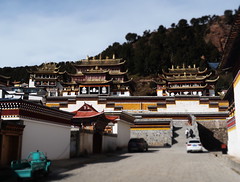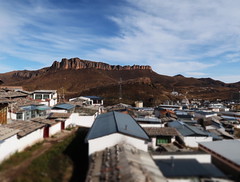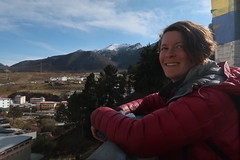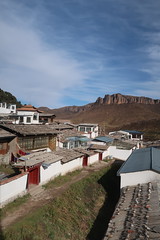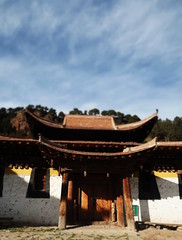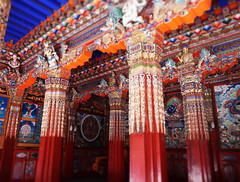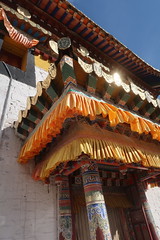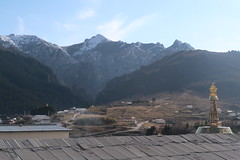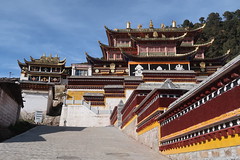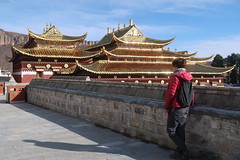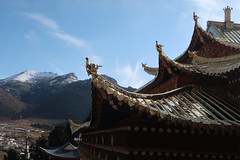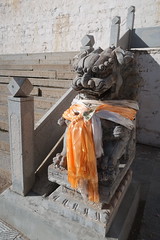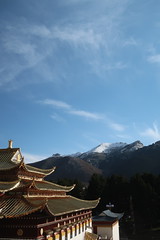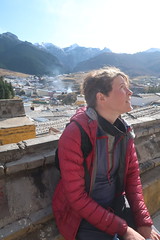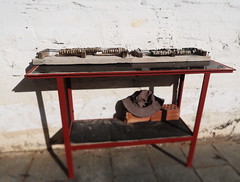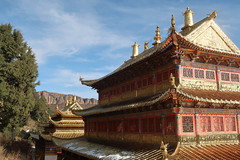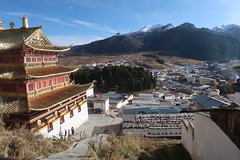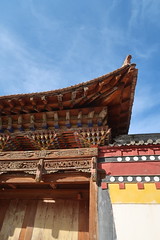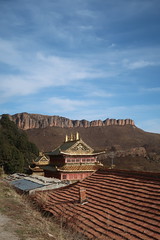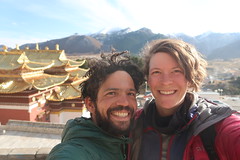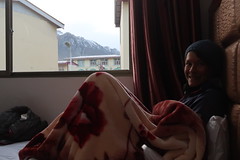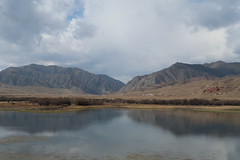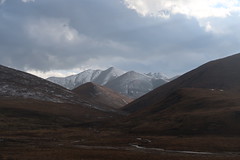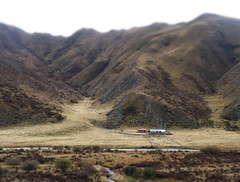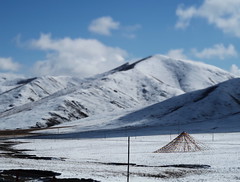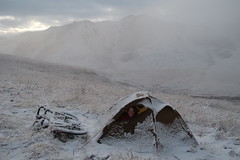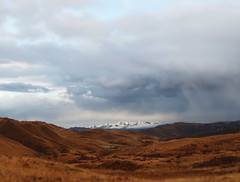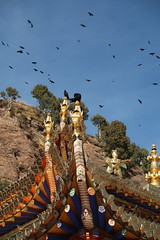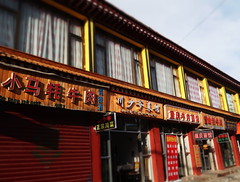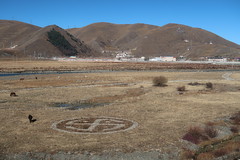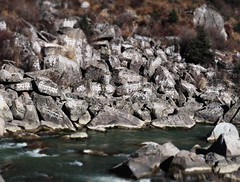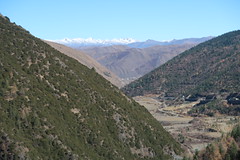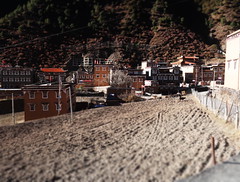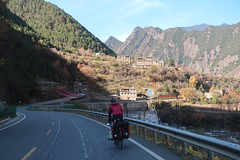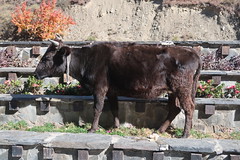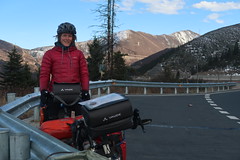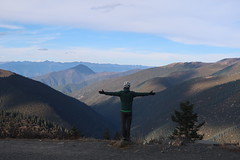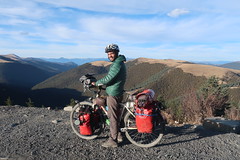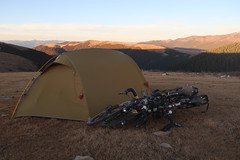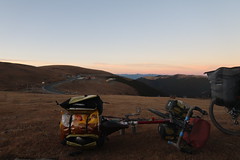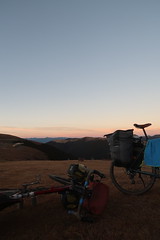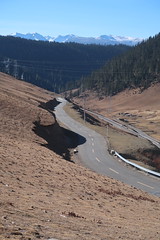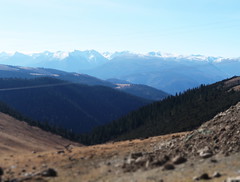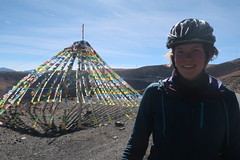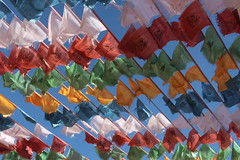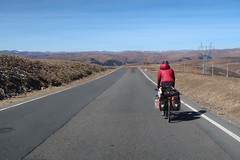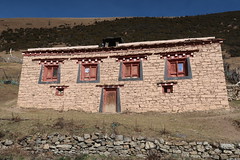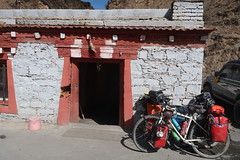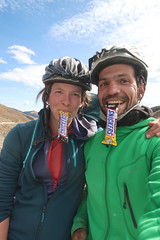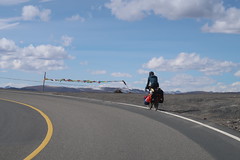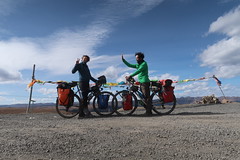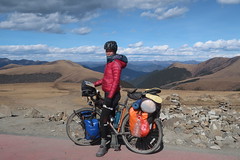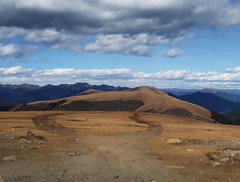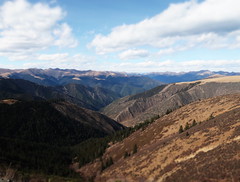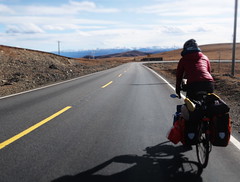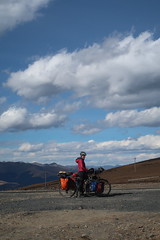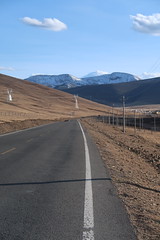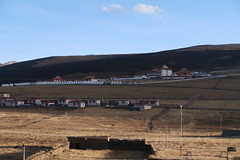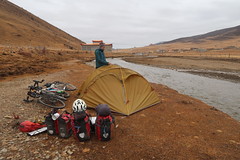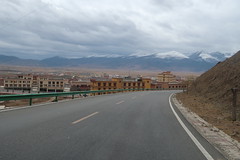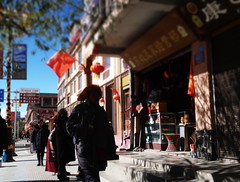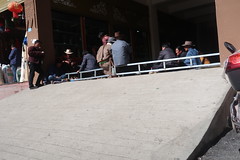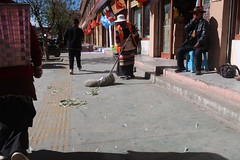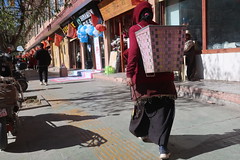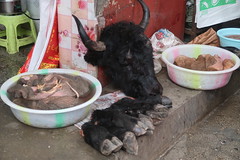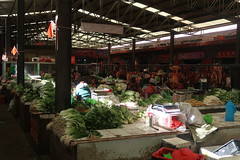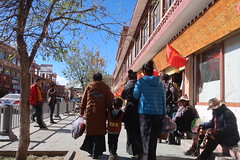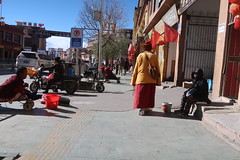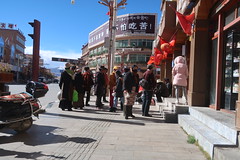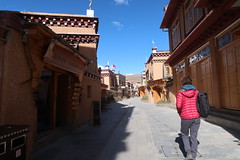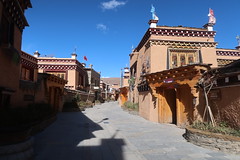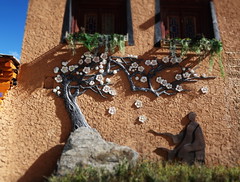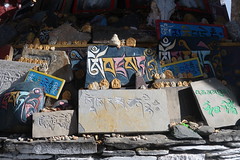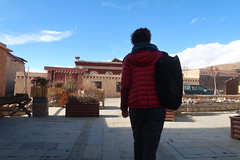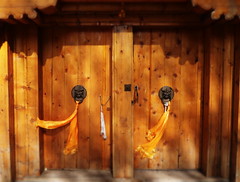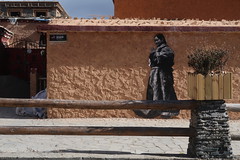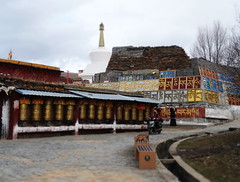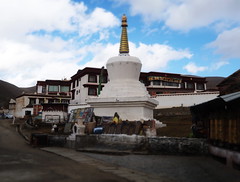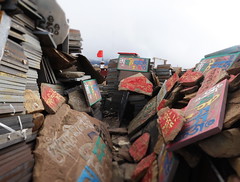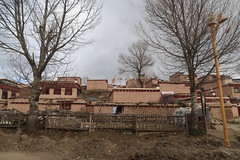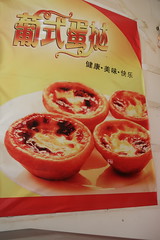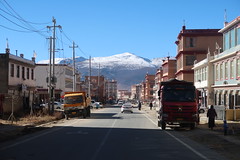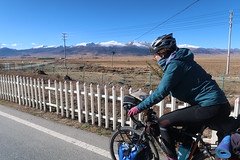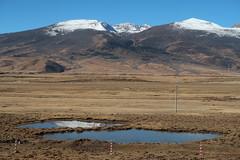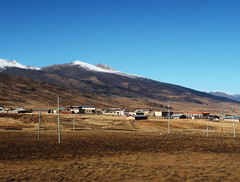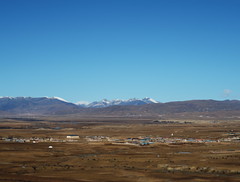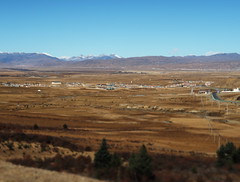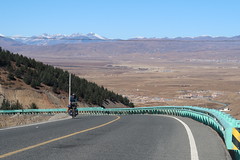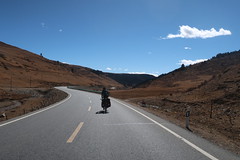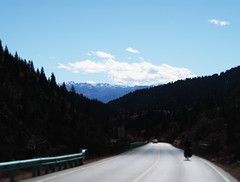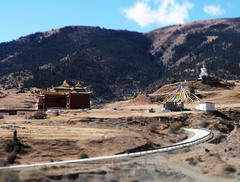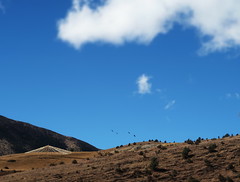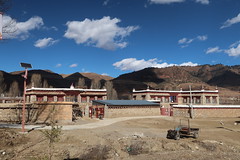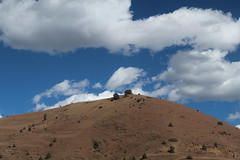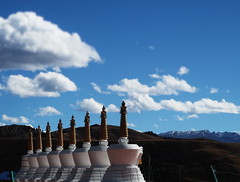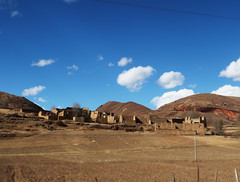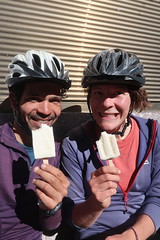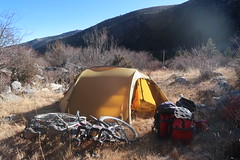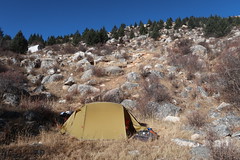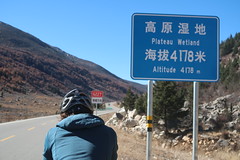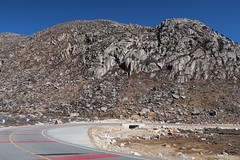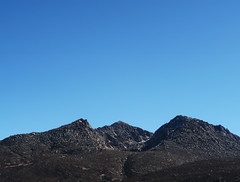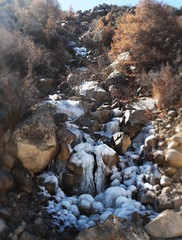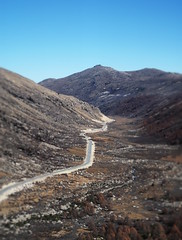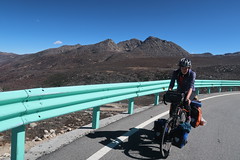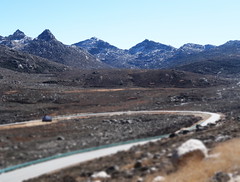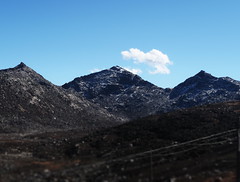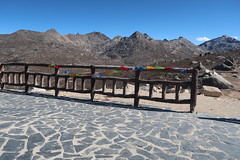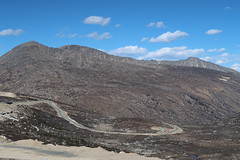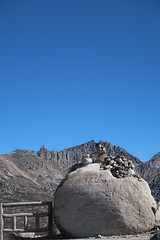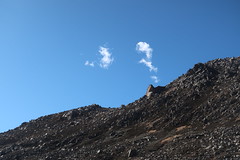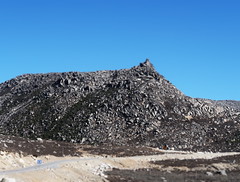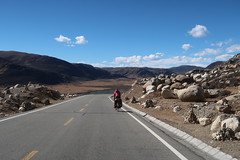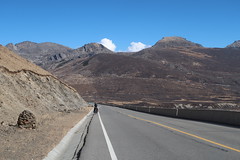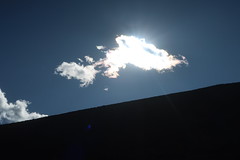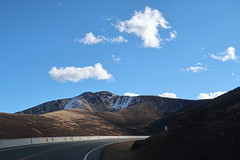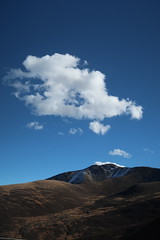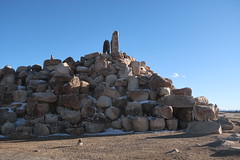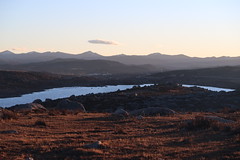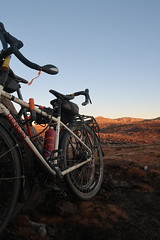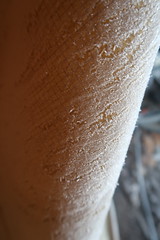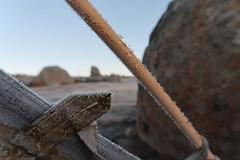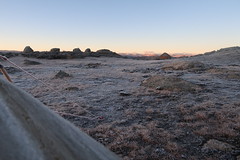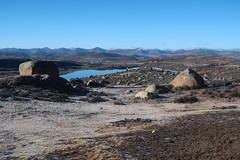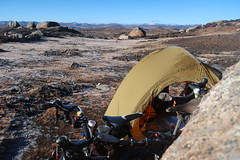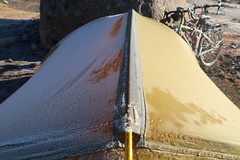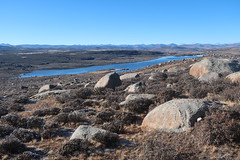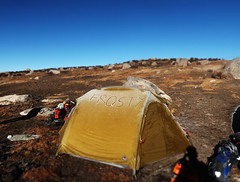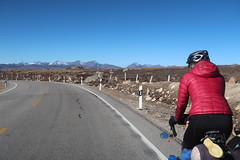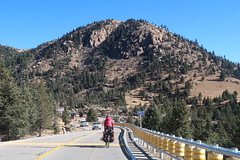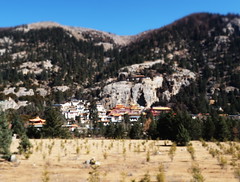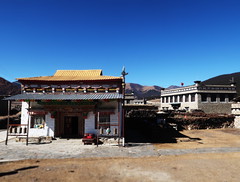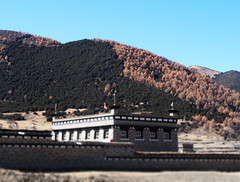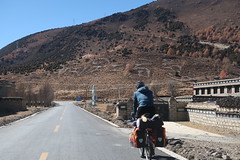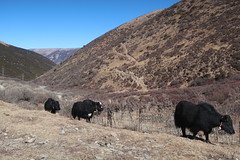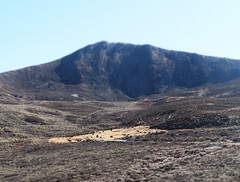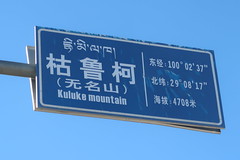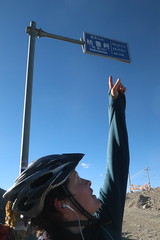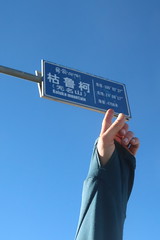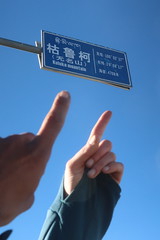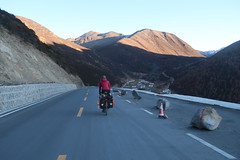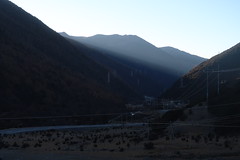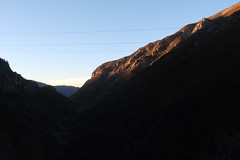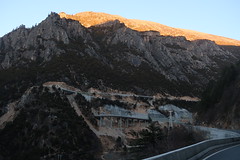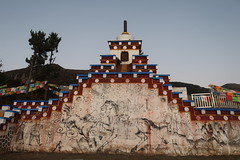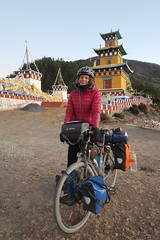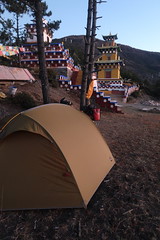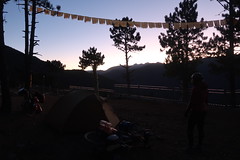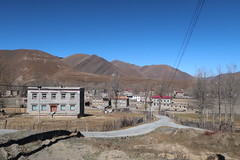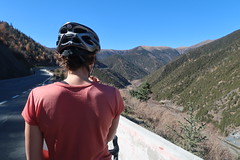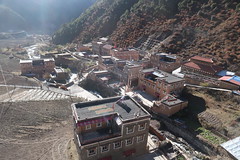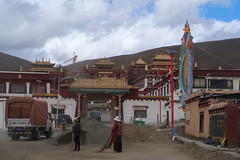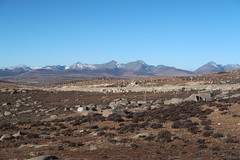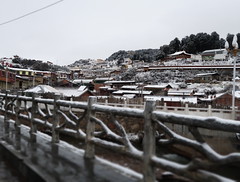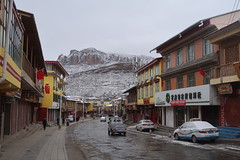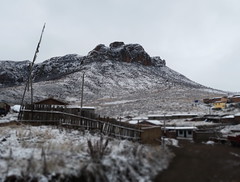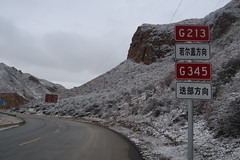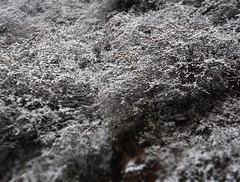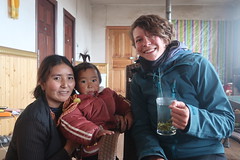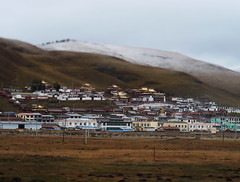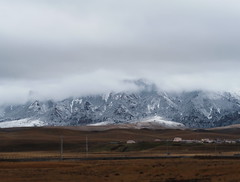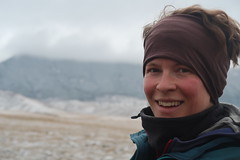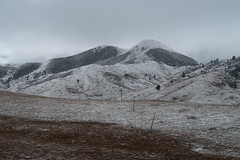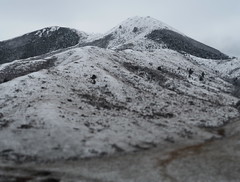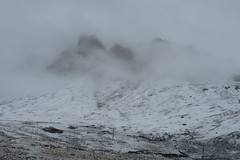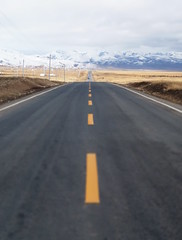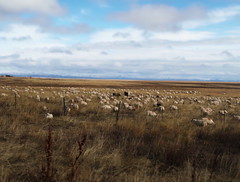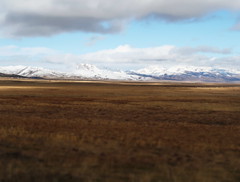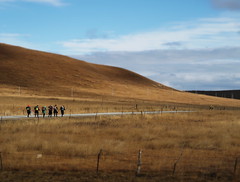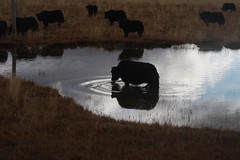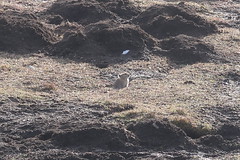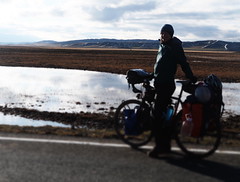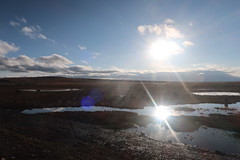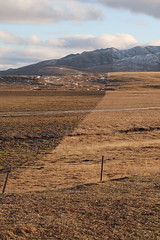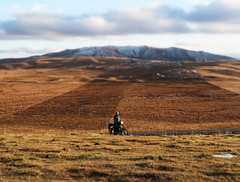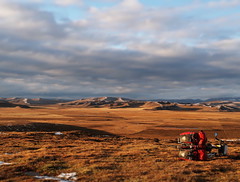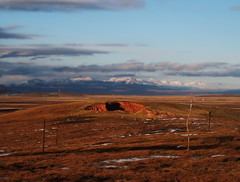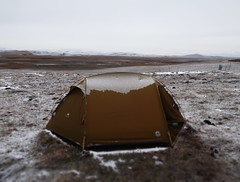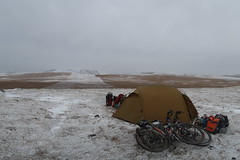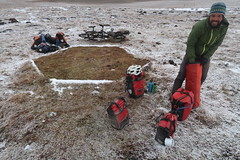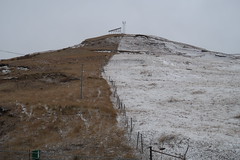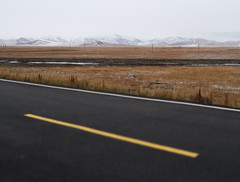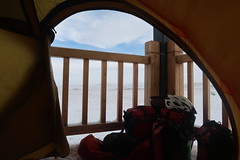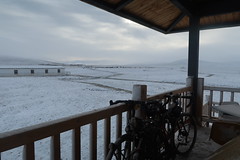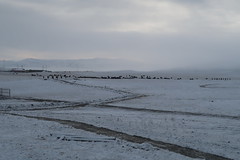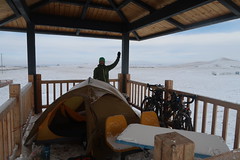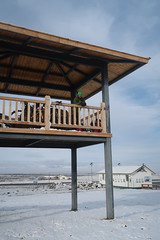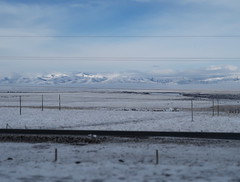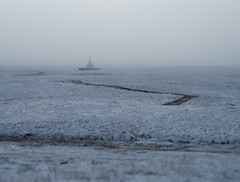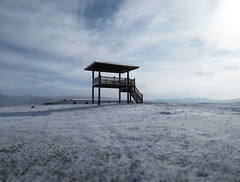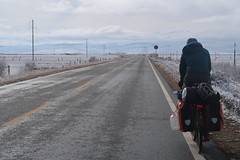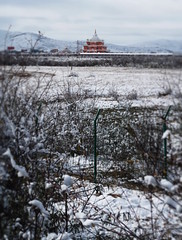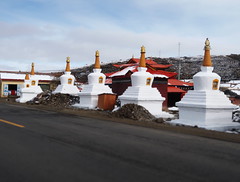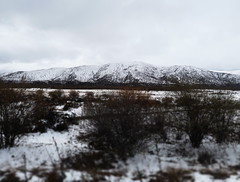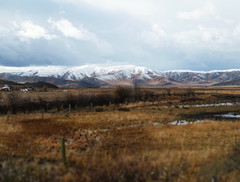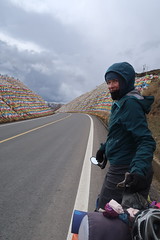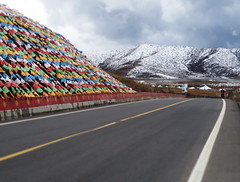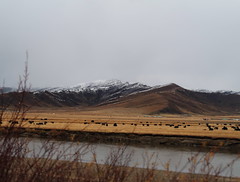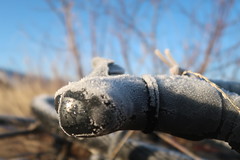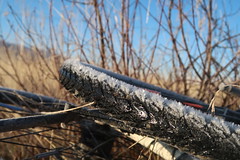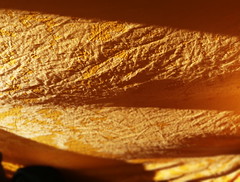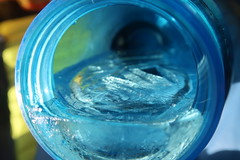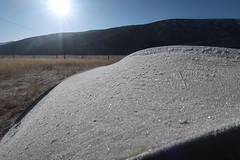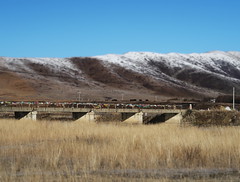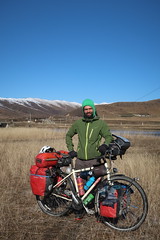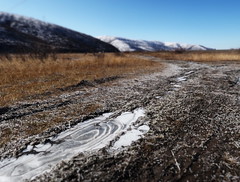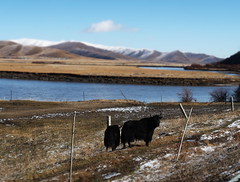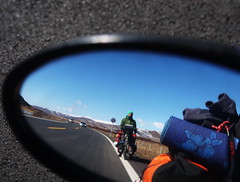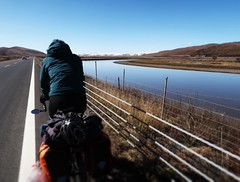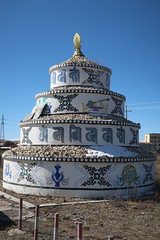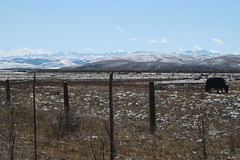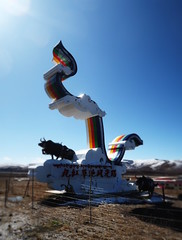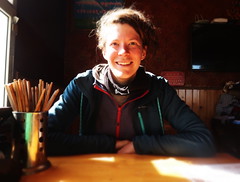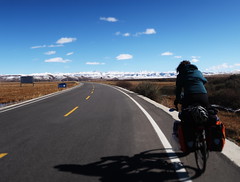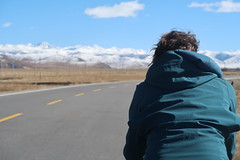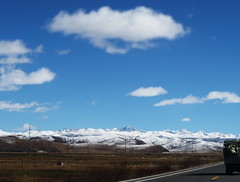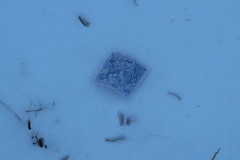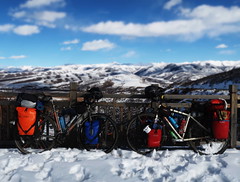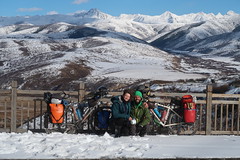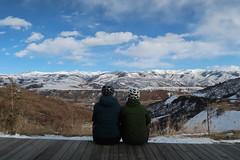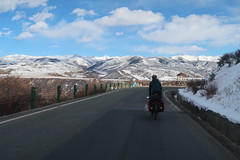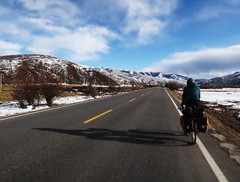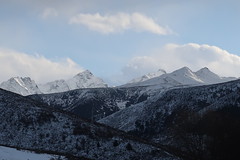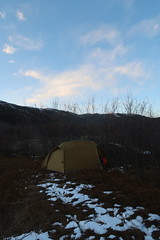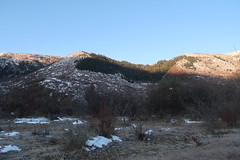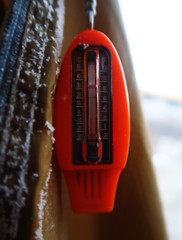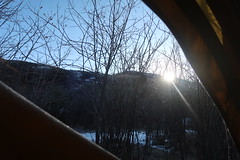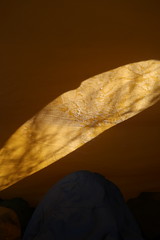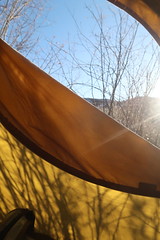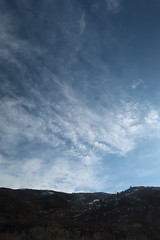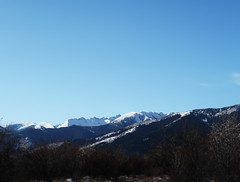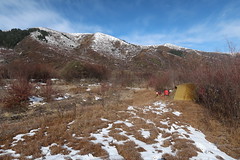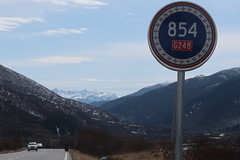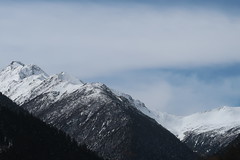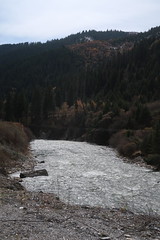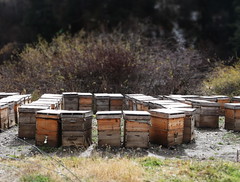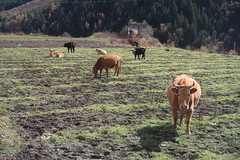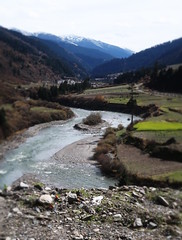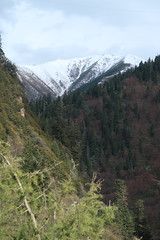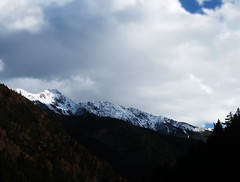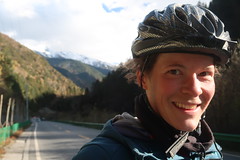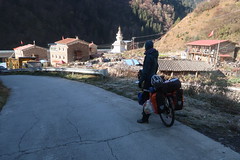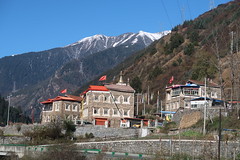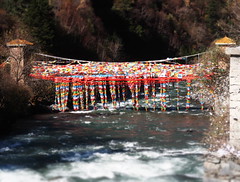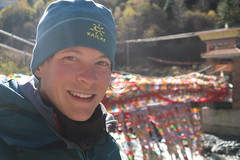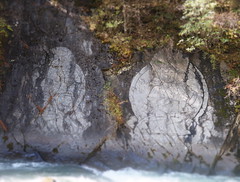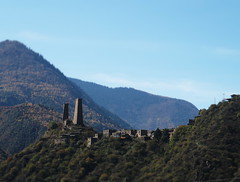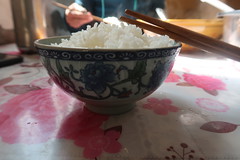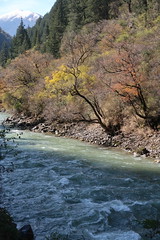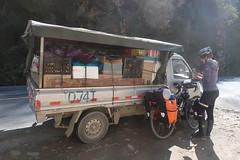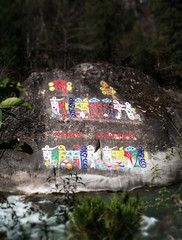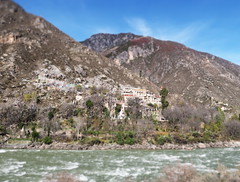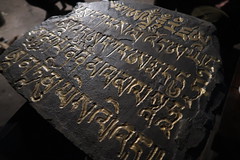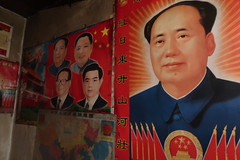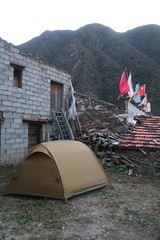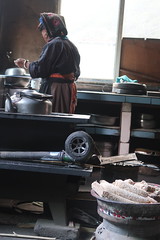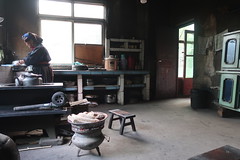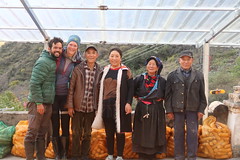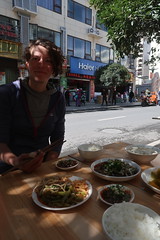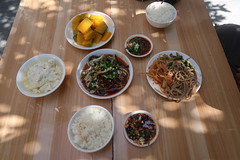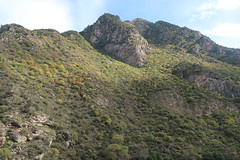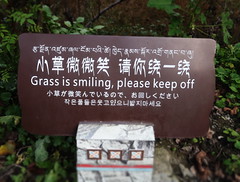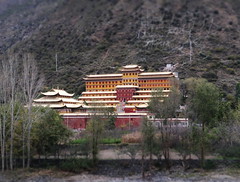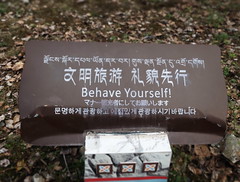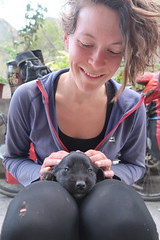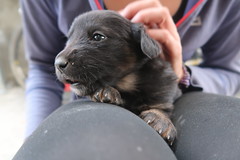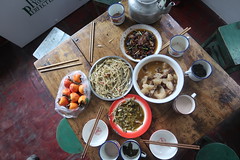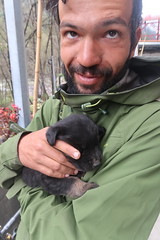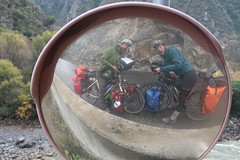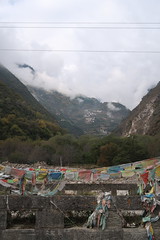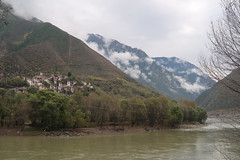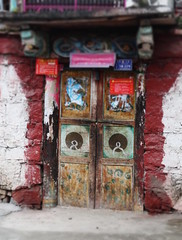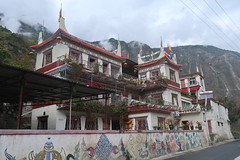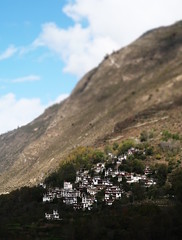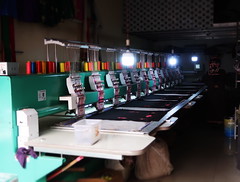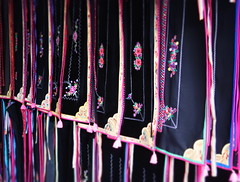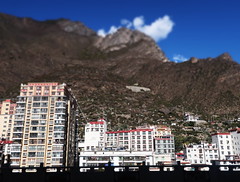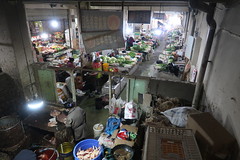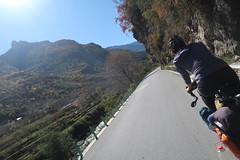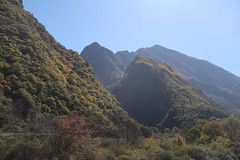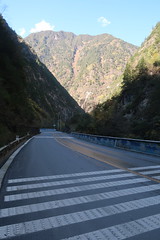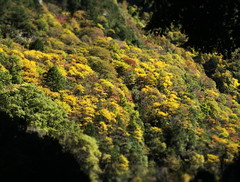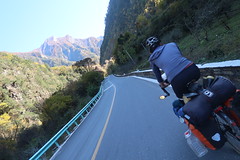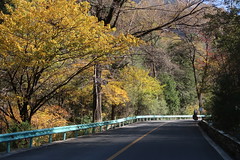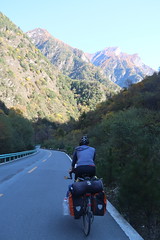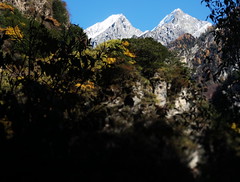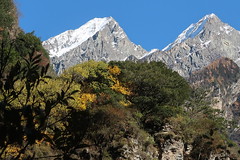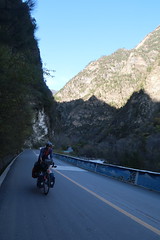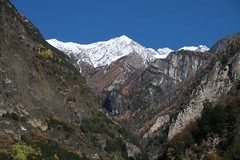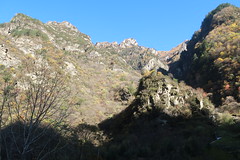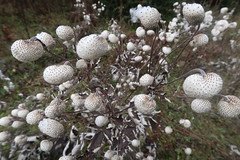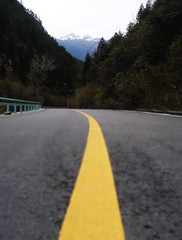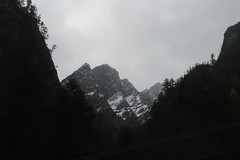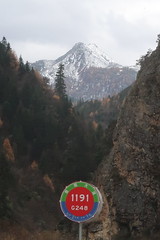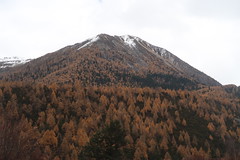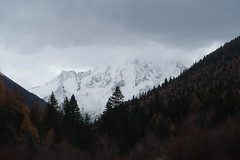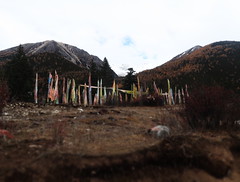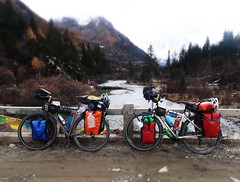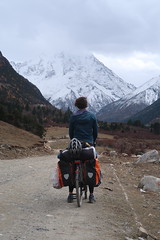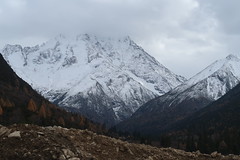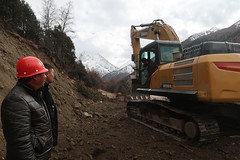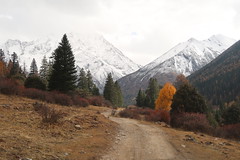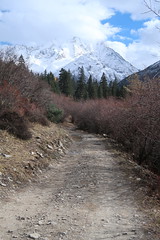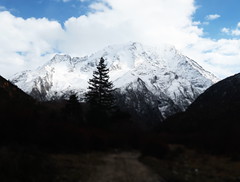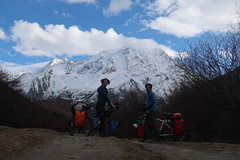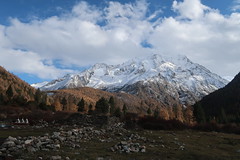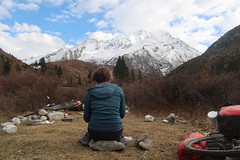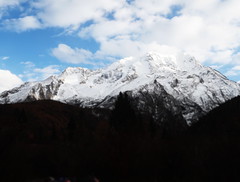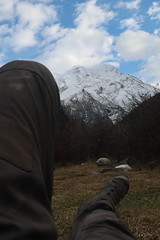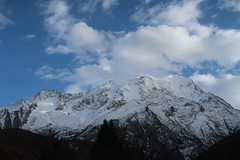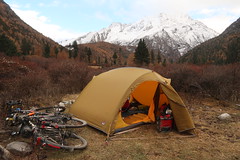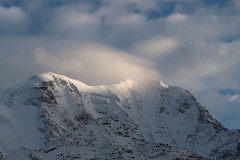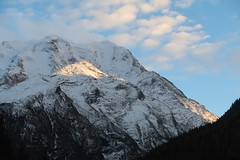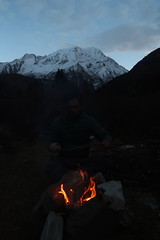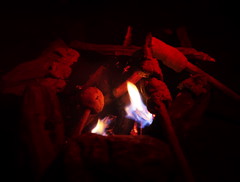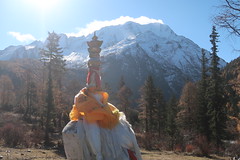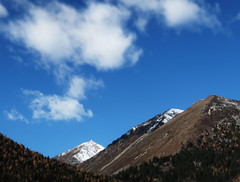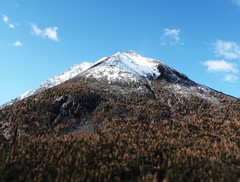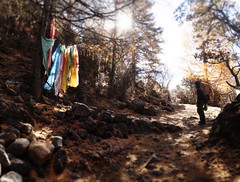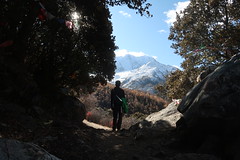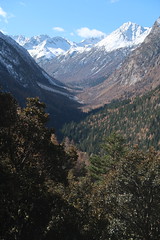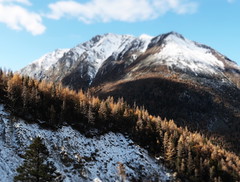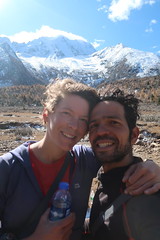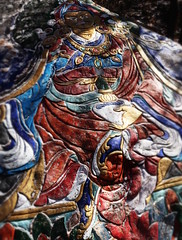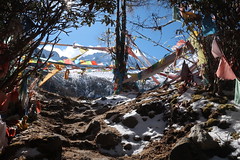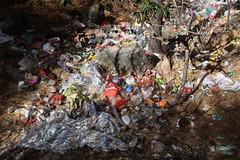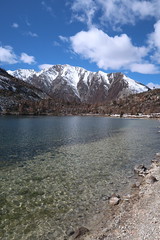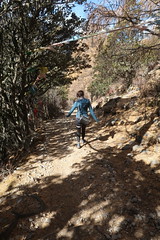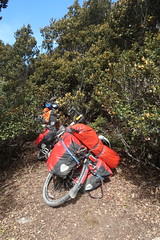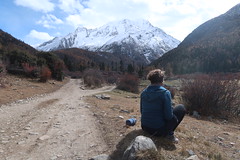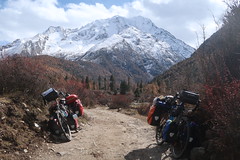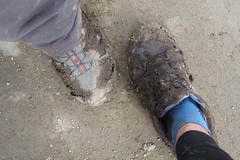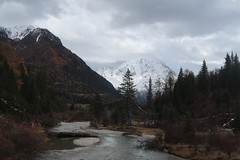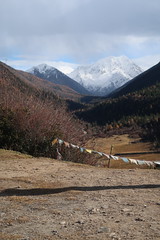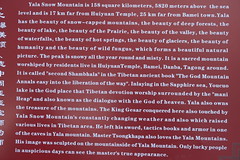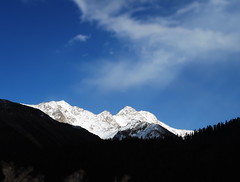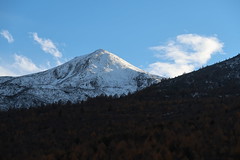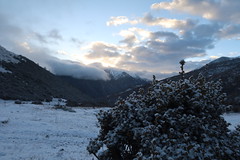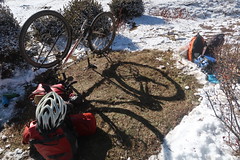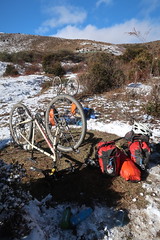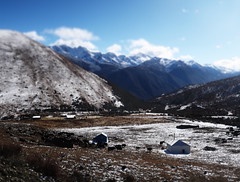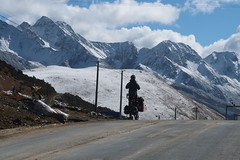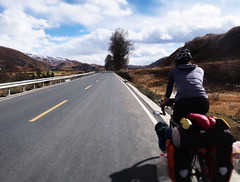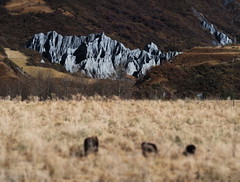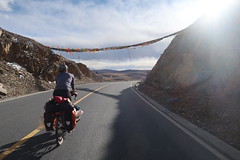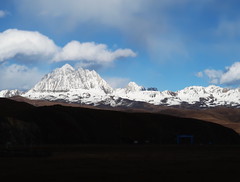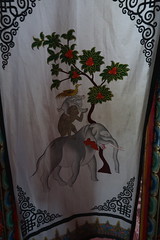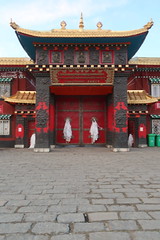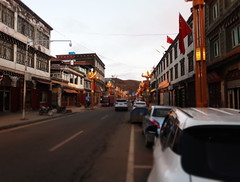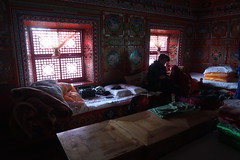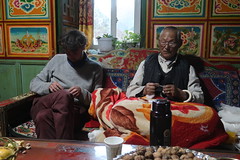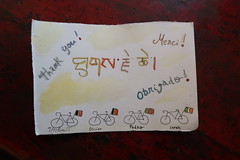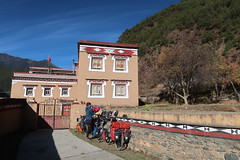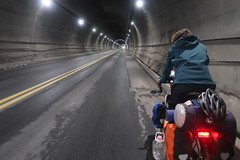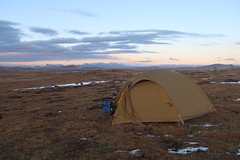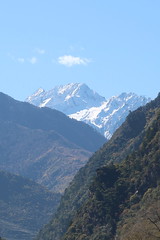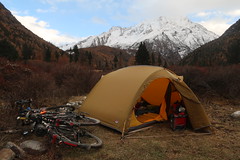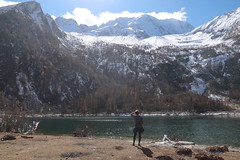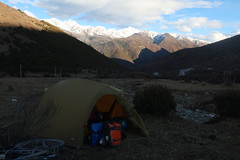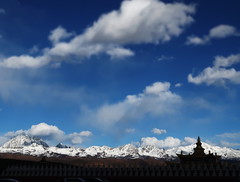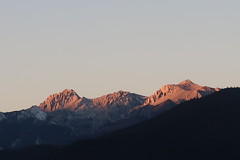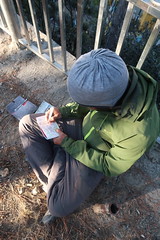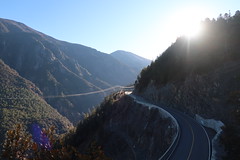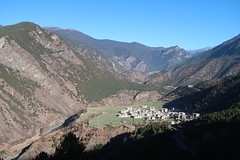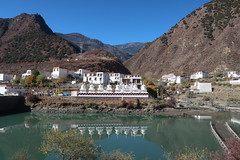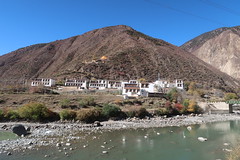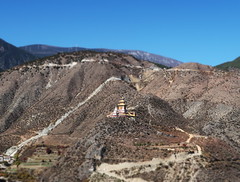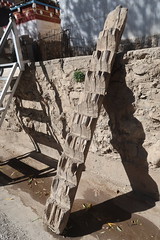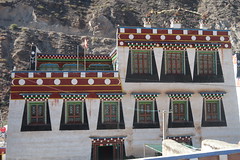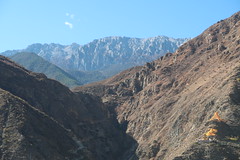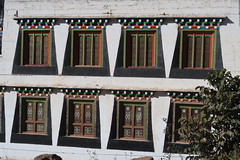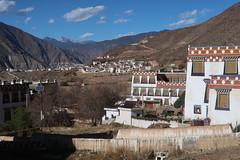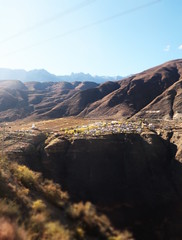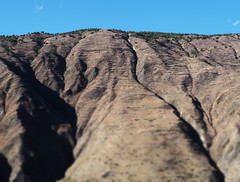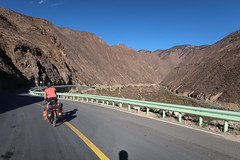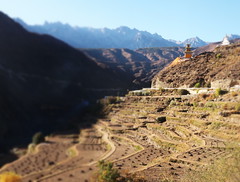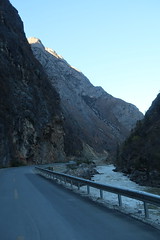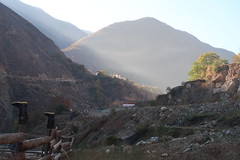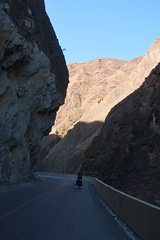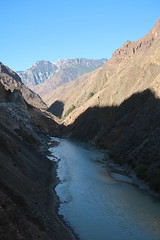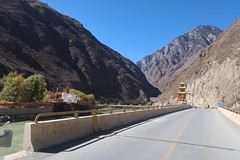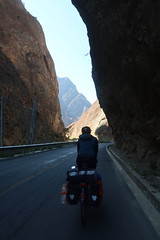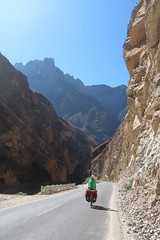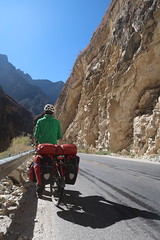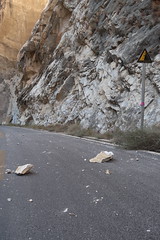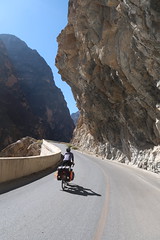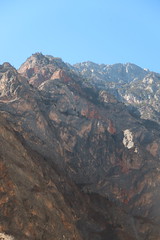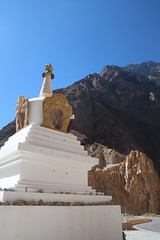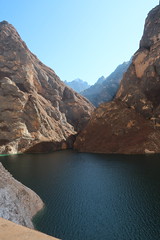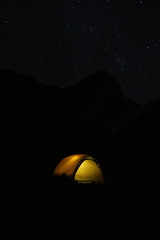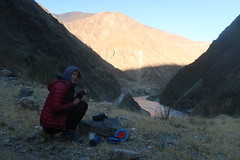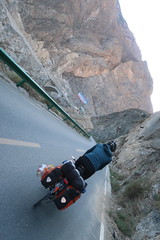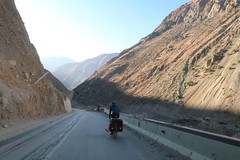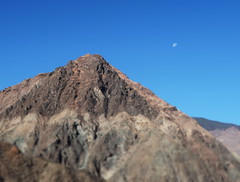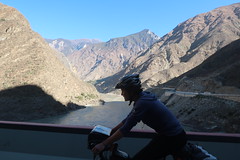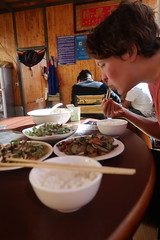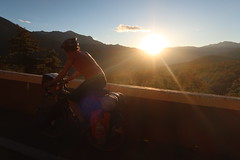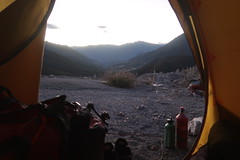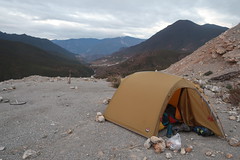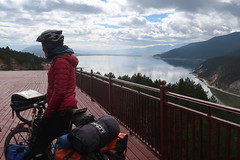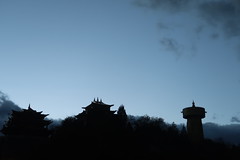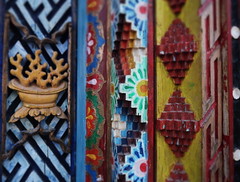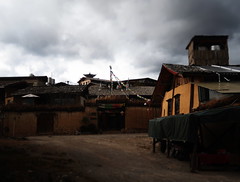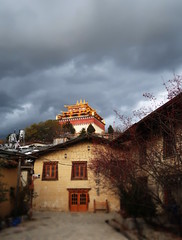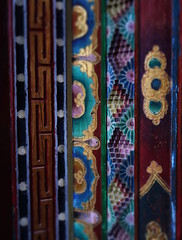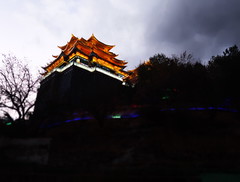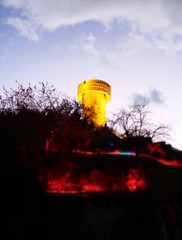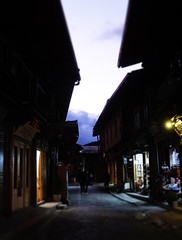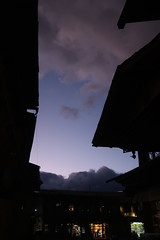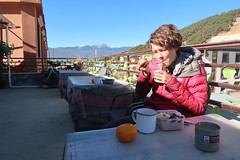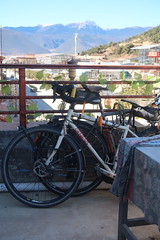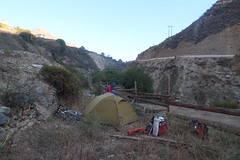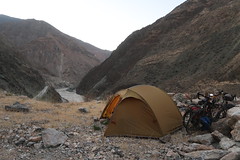A few days after heading away from Lanzhou it soon become clear that we were gradually entering a different region. Signs started having not only Chinese characters, but also Tibetan script. On the horizon a few golden roofs of a temple or a stupa began to pop up. A few colorful flags dancing in the wind started to appear here and there, soon everywhere.
When we left, our notion of geography, and perhaps more importantly geo-politcs, was, we found later, still rather small. Or perhaps we were just a bit naive. For example, we thought we could cross from Turkey straight into Armenia, unknowing or forgetting all about the Armenian genocide back in 1915. And we also thought we could cross from China into Tibet and from there into Nepal….
We were perhaps just oblivious dreamers when looking at maps and thinking of all the places we wanted and hoped to reach. The harsh reality is that anyone who wishes to travel in Tibet needs to do so with the permanent company of a local guide (therefore controlling your every move…) making such journey quite an expensive one.
This meant that not only were we not going to Tibet, as it is perhaps the most expensive part of the world to cycle in (slow traveling does not carry so well when you are basically paying by the day for a local guide) but it also meant we would also have to change our plan and have to choose between cycling in China or Pakistan, India and Nepal. In the end, our slow pace in contrast to the fast one of seasons, determined our choice. There was some relief in that fact that although we would not be in Tibet (the Autonomous Region of Tibet that is), we would still be able to cycle through what is historically, and culturally, Tibet.
When the Chinese took over the region they decided to separate the Tibet Autonomous Region (T.A.R.) and incorporate the remaining regions (comprising both the Amdo and Kham regions of historical Tibet) into the existing Chinese Provinces of Gansu, Sichuan and Yunnan. The map in this link illustrates this ravaging division. It happens that in fact, nowadays, there are more Tibetan people living in these provinces than inside the so-called (T.A.R.) region.
So besides the architectural aspects changing, it is fair to say, so did the people. People’s skin seemed more tanned and aged from the sun and the cold. Men’s clothes were now mostly long fluffy coats with long sleeves reaching as far as the knees when hanging down. Women adorned their clothes with long beaded neck lasses or earrings. But on all of their faces were their smiles. People in this part of the world have the greatest smiles. Some of the best we have seen on our trip. They smile with their eyes. And with their smiles, comes kindness.
On a day of grey cold weather we were welcomed in to the back of a shop, where we had bought some basic fruit, by the nicest old lady. She warmed up her stove for us, and gave us hot tea and some cookies to chew on, as we warmed up our feet and souls. When we took her photo, she beamed at us with such joy. She had so little but was proud to share what little she could.
Later on, on that same day, we were surrounded by kids with their laughters and cheeky but proud “hellos” and they jumped with joy as we made some soap bubbles for them. When it was time to go we said goodbye, they happily and smiley replied back “bye bye”, with the greatest smiles of simple happiness that we had seen.
Still on the same day, when understanding that we were going to cook outside their shop (since hadn’t been able to find a restaurant), a young girl and her mum invited us inside to use their kitchen. They even provided us with more ingredients to add to our scrambled eggs and told us to sit and eat by their stove, as they watched us in bemusement.
As we lay in the tent that night we wondered if we had had a super lucky day, meeting all these kind people or if it was simply that the nicest people were just waiting here to be found…
Unnaturally to our usual cycling pattern, our path through the Tibetan plateau was guided by connecting towns instead of nature like lakes, gorges and high mountain passes. As in most countries we were still very much attracted to the natural beauty and meeting as many people as possible but here we felt specially an appeal to get to know the culture and the traditions. And so we headed to towns and monasteries.
We visited both Labrang and Taktsang Lhamo with that purpose. And given the cold nights, we confess, with also the hope of a good nights rest in a warm bed. Labrang was the first town we had been with a major temple and, perhaps because of that but also because it is one of the main Tibetan pilgrimage destinations, we were simply amazed by the whole experience.
The dimension of the
temple complex, with endless golden roofed temples and stupas. The
number of pilgrims and followers, turning the prayer wheels going all
the way around the monastery. The amount of color and life, but at
the some time, serenity. There was just an indescribable peaceful
vibe to the place. We wandered around aimlessly, unsure of the
practices of Buddhism within the temples and what we were allowed to
do or not, but simply enjoyed soaking up the atmosphere of the place.
From Labrang we quickly arrived also to Taktsang Lhamo (also known by its Chinese name of Langmusi) and although the surrounding landscape was truly beautiful, with alpine snow-covered forest and impressive cliffs, we found the monasteries to be a bit more empty and museum-like, making us realise how truly special Labrang had been.
We spent two nights in Langmusi, one to visit the two temples (the one funded by the Chinese government with rich golden roofs and the other more authentic Tibetan temple) and the other day, well, basically to see the snow fall outside. It snowed the entire day and we spent it almost entirely laying in bed.
Not only out of need of rest but mostly because it was the only warm place of the room or even the whole hotel (we were the only ones there). In these parts of the world, despite the freezing cold winters, hotel rooms have no heating. The only salvation comes in the form of electrical blankets, to which we must say, we became very much… attached… Any time spent outside the bed – not sandwiched in between the electrical blanket and the (hopefully) heavy warm blanket; was spent shivering and in pain.
When we left Langmusi the next day, our bicycles were covered in an interesting layer of snow we had to brush of with a broom and hands. Needless to say it was still quite cold and so we made the mistake to start the day as we would mostly spent it: cold.
It was one of those days… The sky was pretty grim and grey and it felt very hard to believe there was a sun behind it. We hadn’t made more than 10km and our toes were unbearably frozen. We were literally in pain. We had made the mistake of leaving too cold to begin with. We should have jumped back into bed with the precious electrical blanket to warm up after packing and taking down the bags and clearing the snow away from the bikes.
The cold was just unbearable, so when saw a house with a smoking chimney, we hoped it was a café or restaurant were we could warm up our feet. It turned out to just be someone’s house, but when they saw us through the window, shivering in cold, they ushered us inside. Soon we were sat with our toes next to the stove, having warm tea and exchanging smiley looks and gestures as a way to overcome the language barrier.
Their
2 year old daughter, shy at first, soon gained ease and shortly after
we arrived was playing and giggling with us. When our limbs recovered
some warmth and color, we placed our (toes/life saver) wellies back
on together with all our layers and prepared to leave. They refused
any donation and waved us goodbye, our toes and ourselves feeling
much better.
Later as we continued cycling, the sky gradually,
but still somewhat suddenly, changed from grey to blue. By the end of
the day, we were being treated with the most beautiful yellow light
that turned the landscape of yellow fields and white mountains into a
simply amazing sight. We couldn’t believe it. It was like a
completely different day…
We were now entering what in know as the Zoige grassland. The landscape was amazingly remote, surrounded by snow covered hills and countless yaks grazing. When the sun shined the yellow tones of the grasses, contrasting with the white of the snow, was just amazing.
This was also perhaps were we were the coldest. At this stage we had been cycling above 3500 m for a while and the temperatures had dropped quite significantly. We thanked our lucky starts that Matt, our warmshowers host back in Almaty, who had also cycled these parts, had suggested to us the use of wellies (plus as any socks as you could fit). Besides those, all sorts of tricks were tried to try and keep us warm, namely the extremities. From plastic gas station gloves in the hands, to foil crisp bags on the feet.
Any camping location also had to be chosen most carefully. This wasn’t in fact that easy since there were countless fences to protect the grasslands or contain the grazing yaks from crossing the road. Finding an accessible flat camping spot invariable involved pushing the bike up some insanely steep and wet hill. Almost everyday we would completely destroy ourselves to get the bikes up, most times having to push a bike at a time, and ending up drenched in sweat. Well, at least we would go to the tent warm, although damp.
The orientation of the tent also became a major factor. The compass was put to use to find the expected location of the sunrise, which was a moment we eagerly waited for every morning before being able to leave our beloved sleeping bags. The thermometer (which we suspect was not saying low enough) read as low as -10 when we woke up. There would be almost as much frost on the inside of the tent as there was on the outside… Interesting days!
After several days of fighting off the cold and frost, we were delighted (and even somewhat suprised) when we started heading down the high plateau to more lower grounds through what turned out to be some amazing green gorges.
We had initially planned to visit a natural park further to the East, but when we realised that it was not only incredibly overpriced but also only possible to go in a group tour, we changed our route and headed South and more importantly, down!
As we did, it felt like we were not only going down in altitude, but also back in time. It was Autumn again! Trees, red and yellow leaves and a pleasant temperature that meant we didn’t had to wear those 5 or 6 layers, or even imagine, after cycling with plastic bags in our hands, cycle without gloves!
The further down we went, the warmer it became and the less clothes we needed. We wandered through this beautiful valley, covered in Autumn colours trees and dotted with only a few small villages where people in very traditional clothes cheekily threw the occasional ‘hello’ and ‘byebye’. We knew we would still have to go back up to the mountains, quite high in fact, but it sure was good to have a break from the cold and have a bit of an autumnal feel!
This was also when we got to experience some more of the Tibetan hospitality. The valley we were descending was incredibly steep, on either side. As impressive as that was to look at, it also meant that finding a flat space to camp was virtually impossible. We resorted then to ask the local villagers and had all sorts of different experiences.
Once after asking to camp somewhere in the village we were vaguely pointed to a field up the hill and left undisturbed, unvisited and alone for the remaining time.
The next day, after being offered to camp in someone’s backgarden, which turned out to be on the top of the most incredibly steep path, we were given a spot to camp outside but invited inside to share some food. We sat inside their kitchen, walls covered in black from the smoke of the fire, shared food, laughs and photos, as we attempted conversation through gestures and the apps on our phones. I had to chuckle when the grandfather who was watching TV and zapping between channels decide the one he wanted to watch was the one showing an indoor speed climbing competition.
Finally, the next day after asking to camp in the empty field across from a house on the other side of the road, we were offered not only to share food with them but also a room with a very spacious and comfy bed. Never anything was expected, or even accepted, in return. Accepting wandering travelers just seems to be part of their culture here.
This lush green gorge was initially meant to lead us to Kangding, but when we casually stopped for a snack a few kms before the intersection in the town of Danba, and had a closer look at the road ahead. We realised we would be basically be going through 90 kms of tunnels! Given our lack of desire or interest in cycling through endless unlit, unventilated, unfriendly honking tunnels, we decided instead to head West towards Tagong.
Much to our joy, the road from Danba towards Tagong, turned out to be one of the most beautiful roads in the area! It was meant to be! Imagine if we hadn’t stopped for the snack! Soon after leaving Danba we were cycling along a beautiful valley, with even more beautiful autumnal colours than before, rugged cliffs and the occasional white peaked mountain in the distance.
After we decided to take the road from Danba to Tagong, we had been told that we would cross one of the more beautiful mountains in Sichuan: Yala mountain or as locally known, Zhara Lhatse.
When hearing this, we decided that such a place was definitely worth a detour, and embarked on what was one of the most beautiful experiences we have ever had. We basically had an amazingly beautiful ‘holy’ mountain and lake just to ourselves!
We knew it was a dead end road, at least for us with the bicycles, and we knew the weather could turn for the worse quite soon and quite quickly. In fact as we headed to this amazing white covered peak, the weather was grey and not very promising. But nonetheless we headed towards it, attracted to its magnetic beauty.
It was perhaps the most demanding 14 kms of our lives, through a rough dirt road, but when we reached the end of the track and found the perfect place to setup our tent and contemplate this amazing white mountain, it was well worth it. The peak appeared to be so close but it was still 2000m higher than us, reaching 5820 m high!
No one else was at sight or earshot, so we decided to make ourselves at home and as comfortable as possible. We gathered some wood and started a fire to warm us up and decided also to use the remaining gluten-free flour, which we had been carrying for the last almost 1000 km (ever since Almaty, Kazakhstan!), and bake some camp fire bread (which didn’t turn out so great, but oh well).
It felt insane to be so close to such a beautiful mountain and to have it just to ourselves. Especially after reading how ridiculously expensive the entrance to most of the nature parks is in China. We knew also that the some fate was most likely coming to this place, as we had had to overcome some construction sites and diggers to get to this place. Soon there would be park entrance ticket offices, fences, housing and perhaps even gondolas and lifts. The fact that there was none of this here yet and it was just us and the nature around us, made it a unique and so much more meaningful experience.
The next morning we hid the bicycles behind some bushes and hiked (again entirely by ourselves) to the nearby sacred lake Youtso . It was so peaceful by its waters at the base of the mountain. Such amazingly surreal landscapes which could only be ruined by the ridiculous amounts of trash we found gathered in corners of the path. Trash left by supposedly nature loving hikers and campers and even by pilgrims, supposedly believers of the sacredness of the mountain and lake.
After eventually coming back to the main road we found a sign that told a legend about the “mountain’s constantly changing weather” and how only lucky people can see the mountain. That was just how we felt. We were super lucky with the weather as it was cloudy when we started to go towards it, opened up only while we were there camping and hiking the next day, and began to snow as soon as we got back to the road!
After a last camping contemplating the mountain, we woke up again to a snow covered tent, to what was the scariest storm of my life! Even inside the tent, and even with eyes closed, I could see a huge lighting going across the sky (and my frightened eyes). A not so good night sleep with thoughts of lighting attracted to metal bicycles and toasty cyclists…
Glad not to be hit by any lightening and glad to have the chance to contemplate the views one last time, we zoomed down to the other side and reached Tagong at last. We decided to stay in a hostel ran by a Czech guy in a very traditional looking room with the walls painted in allegoric representations of the Jataka tales from the teachings of the Buddha.
The good night’s rest was needed as we were about to cycle to what would be the highest altitude we ever cycled or in fact ever were! And our concerns about the cold were directly proportional to the height. The GPS indicated we would be going as high as 4770 m! Perhaps not that much higher we had been before in Tajikistan, but considerably shifted in time, now December instead of August. Also, it wasn’t just a single high pass we had to overcome, it was a long stretch at considerable high altitude.
When we decided to take this route we had our concerns and tried to prepare accordingly. We bought two pairs of wellie boots, a pair even with fleece inside that we swapped between ourselves everyday, a fleece sleeping bag liner that Sarah was delighted to have at night while I was happy to have her original silk liner transferred to me as an extra.
But in the end however it was all quite ok! Although the seasons had indeed moved, so did we. Further South! A tiny bit closer to the equator, and since we were super lucky most those days the sun was out, which made all the difference. We were actually sweating in our wellies and didn’t had to wear all our layers at all.
There wasn’t even any altitude related sickness, although there was a food poisoning related one. Taken in by yet another generous Tibetan family, they gave so much, they also gave what we did not ask. This time only me was hit, Sarah was mostly left unharmed except for my frequent side of the road stops for vomit and diarrhea.
Nonetheless, after a few mountain passes we reached Litang. Like all the other towns we had aimed for, Litang had been on our Tibetan route for a good while. After quite some planning and concern about altitude and distances, it was interesting to see us gradually reach each that point on our map.
We were however in desperate need for some rest (food poisoning does that to you…) and so we spent some nights in town, mostly in bed under the duvet and as close as possible to the adored electric blankets.
But we did occasionally leave the hostel and wander around town which gave us a good insight. The population was mostly Tibetan, comprising about 75% of the population – far higher than any town we had been through so far. Soon we would be leaving the plateau area so it was interesting to roam the town, admire people’s amazing and varied outfits, observe the gatherings on the street and to be utterly lost in translation with no Tibetan in Google Translate.
Replenished in strength we headed to our last mountain challenge but potential the greatest (or at least the highest). Back in Tajikistan, we thought that the highest high of our trip would be the Ak Baital pass at 4655m. But now ahead of us, was a pass at 4708m. Woop wooo! We were bit thrilled and excited but also a bit apprehensive.
But despite not being so dissimilar in altitude, the two passes couldn’t have felt more different. We huffed and puffed our way up Ak Baital, having to stop every 20m for oxygen and recover some strength and it took us ageeeees to do the last 300m to reach the top. But somehow, in comparison, Kuluke was surprisingly a relative breeze! We wiggled our way but no shortness of breath, no depleted energy and it wasn’t even that cold.
What was the difference? A comparitively better road surface? Less stomach bugs? More nutritious food? The litre of sugary ice-tea we drank on the way up? Or just better acclimatised? We don’t know, but either way, we have loved being up above 4000m again and had very mixed feelings about leaving the high mountains! We were looking forward to warmer mornings, but there is just something so special and unique about the super blue skies you have at high altitude.
We had also our highest camping ever – 4550m! From where we could see both the sunrise and the sunset and the change in light was just amazing. We were perhaps in the limit of our temperature comfort (but luckily not below!) and woke up to a very frosty tent, inside out. At this time of the year the nights were long, so we spent them cocooned in our sleeping bags, filling the hours of darkness with lots of eating, reading and plenty of needed sleeping, waiting for the sun to come defrost the tent in the morning.
As we began our descent from the high altitudes, we entered one of the most crazy gorge valleys we ever cycled through! And we have done our share in France, Turkey, Iran, Tajikistan, … But this was just insane! Both for the shear steepness and verticality but also for how unkept and unsafe it felt.
Loose rocks were scattered all over the road and many others were just waiting to hit the head of an innocent passing cyclist. You look up and you can just see it happening… The worst nightmare for any rock climber. It felt crazy how this could be a road open to the general traffic. The feeling of vertigo with cliffs of more than 1000m at each side, massive crevices in the tarmac and all the loose rock just waiting to fall… It was beautiful and a thrill to see it, but we were quite eager to leave the scary valley and pedal into more open ground…
Eventually we did and found ourselves again surrounded by more fertile fields and inhabited places. Villages gradually started to appear and it was amazing to see all their different house constructions. The Tibetan architecture feels so interesting. Embroidered colorful windows, large wooden doors and big open terraces. I felt like buying one just for some holiday vacations. In China… Right…..
nother interesting architectural aspect was the typical restaurant. There was somewhat a distinction between Tibetan restaurant and Chinese restaurant, but we could mostly only attend the last, as the first would mostly only serve meat (which doesn’t go so well with vegetarians) and dumplings (which doesn’t go so well with a coeliac). The restaurants ranged from pretty basic – an open kitchen and few low tables and small benches on the floor; to more fancy – circular tables and a kitchen somewhere in the back. For obvious budget reasons we only attended the basic ones.
China has been the first country where food has been cheap enough that our budget allows us to eat in a restaurant or cafe at lunchtime. It represented a chance not only to eat and recover some energy but also to get out of the cold and stock up on hot water, which you can find everywhere in China.
Every restaurant would have a little sign stating the hygiene rating of the place. It felt that most people wouldn’t care much about it, it was just something they were forced to have. Nonetheless, it didn’t take us long to realise that the hygiene c-rated places were the best ones for our budget, stomachs and entertainment! Chickens going about the floor, sometimes a travelling cockroach and most often the more interesting crowds and owners.
We were now approaching the renown town of Shangri-la. The fame however might come from a different place depending on the listener. It is in fact a name taken from a novel called Lost Horizon written by James Hilton in 1933 which the Chinese authorities borrowed with the hopes of boosting tourism, and therefore economy, in the region. It might have worked but the town felt nothing more than a tourist theme park, filled with shops all selling the same things.
We were clearly by now starting to depart the remote and culturally intrinsic and deeply interesting part of the Tibetan Plateau. As we did, we started to reflect on all the things we loved about this amazingly diverse region…
Golden grasslands full of rectangular nomad tents instead of yurts, and hundreds and hundreds of yaks. Beautifully decorated houses, and super colourful traditional clothes for both women and men. Stunning snow covered mountains, crazy crazy gorges and valleys, with colourful prayer flags fluttering in every corner. Maze like temples, rows of prayer wheels and stupas big and small! Curious smiling people, always ready to give us a cheeky hello and a thumbs up.
We had an amazing time…

